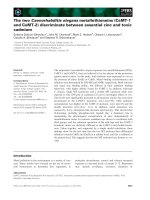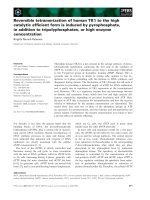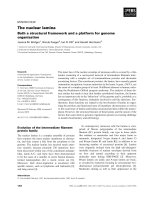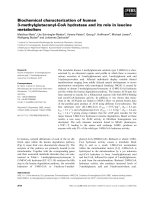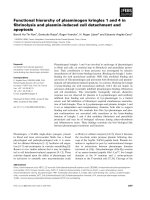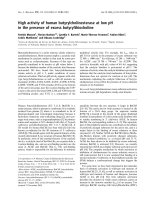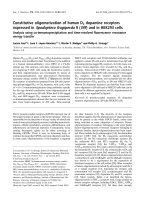Báo cáo khoa học: The use of synthetic linear tetrapyrroles to probe the verdin sites of human biliverdin-IXa reductase and human biliverdin-IXb reductase potx
Bạn đang xem bản rút gọn của tài liệu. Xem và tải ngay bản đầy đủ của tài liệu tại đây (456.1 KB, 9 trang )
The use of synthetic linear tetrapyrroles to probe the
verdin sites of human biliverdin-IXa reductase and human
biliverdin-IXb reductase
Edward M. Franklin
1
, Seamus Browne
1
, Anne M. Horan
1
, Katsuhiko Inomata
2
, Mostafa A. S.
Hammam
3
, Hideki Kinoshita
2
, Tilman Lamparter
4
, Georgia Golfis
1
and Timothy J. Mantle
1
1 School of Biochemistry and Immunology, Trinity College, Dublin, Ireland
2 Division of Material Sciences, Graduate School of Natural Science and Technology, Kanazawa University, Ishikawa, Japan
3 Department of Chemistry, School of Science, Nagoya University, Aichi, Japan
4 Institut fu
¨
r Botanik I, Universita
¨
t Karlsruhe (TH), Germany
Introduction
The reduction of biliverdin-IXa to bilirubin-IX a catal-
ysed by biliverdin-IXa reductase (BVR-A) comprises
an ancient reaction that has been conserved through-
out evolution from cyanobacteria to man [1,2]. Until
recently, the pathway in mammals has been considered
functionally as the catabolic elimination of excess
haem. This view has been challenged by recent
observations that haem oxygenase plays a major
cytoprotective role [3], and there is clear evidence that
bilirubin-IXa is a physiologically significant antioxi-
dant [4]. Central to this model is the enzyme biliverdin
reductase, which is responsible for the maintenance of
Keywords
Biliverdin, dimethyl ester, ditaurate, inhibitor,
jaundice, tolerance
Correspondence
E. M. Franklin, School of Biochemistry
and Immunology, Trinity College Dublin,
Dublin 2, Ireland
Fax: +353 1677 2400
Tel: +353 1896 1612
E-mail:
(Received 23 April 2009, revised 9 June
2009, accepted 11 June 2009)
doi:10.1111/j.1742-4658.2009.07148.x
Many vertebrate species express two enzymes that are capable of catalysing
the reduction of various isomers of biliverdin. Biliverdin-IXa reductase
(BVR-A) is most active with its physiological substrate biliverdin-IXa, but
can also reduce the three other biliverdin isomers IXb,IXd and IXc. Bili-
verdin-IXb reductase (BVR-B) catalyses the reduction of only the IXb,IXd
and IXc isomers of biliverdin. Therefore, the activity of BVR-A can be
measured using biliverdin-IXa as a specific substrate. We now show that
the dimethyl esters of biliverdin-IXb and biliverdin-IXd are substrates for
BVR-B, but not for BVR-A. This provides a useful method for specifically
assaying the activity of both BVR-A and BVR-B in crude mixtures, using
biliverdin-IXa for BVR-A and the dimethyl ester of either biliverdin-IXb
or biliverdin-IXd for BVR-B. Human BVR-A has been suggested as a
pharmacological target for neonatal jaundice. Because of the absence of a
crystal structure with biliverdin bound to BVR-A, we have investigated
indirect ways of examining tetrapyrrole binding. In the present study, we
report that a number of sterically locked conformers of 18-ethylbiliverdin-
IXa are substrates for human BVR-A, and discuss the implications for the
biliverdin binding site. The oxidation of bilirubin-IXa ditaurate to biliver-
din-IXa ditaurate is also described. We show that biliverdin-IXa ditaurate
is a substrate for human BVR-A and discuss the possibility of using a com-
peting substrate, which is reduced to a water soluble and excretable rubin,
as a prototypic inhibitor of BVR-A.
Abbreviations
18EtBV, 18-ethylbiliverdin-IXa; BVR-A, biliverdin-IXa reductase; BVR-B, biliverdin-IXb reductase; DDQ, 2,3-dichloro-5,6-dicyanobenzoquinone;
hBVR-A, human biliverdin-IXa reductase; hBVR-B, human biliverdin-IXb reductase.
FEBS Journal 276 (2009) 4405–4413 ª 2009 The Authors Journal compilation ª 2009 FEBS 4405
cytoprotective levels of bilirubin-IXa [5]. This antioxi-
dant mechanism has been suggested to involve cycling
between biliverdin-IXa and bilirubin-IXa [5]. Intrigu-
ing evidence has been obtained from animal transplan-
tation studies [6–8] showing that the administration of
biliverdin-IXa is cytoprotective for the heart, colon
and liver. In a notable study, Yamashita et al. [8]
demonstrated that short-term treatment (3 weeks) with
biliverdin-IXa is sufficient to induce tolerance in a
recipient to the donor heart for 120 days. The intro-
duction of an allogeneic third heart at 120 days was
rejected, whereas the introduction of a third syngeneic
heart was accepted, clearly indicating tolerance [8].
The exact mechanism for achieving tolerance remains
obscure, although it is clear that components of the
haem catabolic pathway play a major role in successful
organ tranplants as well as in physiological cytopro-
tection [4,8].
BVR-A has also been identified as a pharmacologi-
cal target for treating neonatal jaundice [9]. Mammals
maintain relatively high levels of circulating bilirubin-
IXa. This is excreted in the bile, predominantly as a
conjugate with glucuronic acid. At birth, the delayed
expression of glucuronyltransferase UGT1A1 results in
increased levels of unconjugated bilirubin in the liver,
which reflux into plasma. This results in transiently
elevated levels of bilirubin-IXa, which manifests as
neonatal jaundice. If the albumin binding capacity is
exceeded, bilirubin-IXa can partition into the brain
and cause irreversible damage or death.
The design of pharmacological inhibitors for BVR-
A would not only combat the hyperbilirubinemia asso-
ciated with neonatal jaundice, but also might prove
significant during organ transplantation by elevating
the concentration of cytosolic biliverdin-IXa. The pau-
city of information on the biliverdin binding site has
hampered the development of inhibitors of BVR-A.
With this in mind, and in the absence of a crystal
structure of the ternary complex of BVR-A with pyri-
dine nucleotide and biliverdin, we set out to further
probe the nature of the biliverdin binding pocket in a
significant extension to our earlier studies [2]. In the
present study, sterically-locked conformers of 18-ethyl-
biliverdin-IXa (18EtBV) are shown to be substrates for
human BVR-A (hBVR-A), and the implications for
the nature of the binding of biliverdin-IXa to BVR-A
are discussed.
We also show that biliverdin ditaurate is a substrate
for BVR-A and discuss the possibility of using a com-
peting substrate such as this to reduce the levels of the
lipophilic and potentially toxic bilirubin-IXa by pro-
ducing bilirubin ditaurate, which is water soluble and
readily excreted.
Additionally, by studying various biliverdin-IX iso-
mers, we present a method that specifically allows the
assay of both BVR-A and biliverdin-IXb reductase
(BVR-B) enzymes in crude preparations. Catalytically,
the major difference identified to date between the two
human enzymes is that BVR-B catalyses the reduction
of biliverdin-IXb, biliverdin-IXd and biliverdin-IXc,
but not biliverdin-IXa [2,10]. BVR-A prefers biliverdin-
IXa as substrate, but can reduce all three other isomers
[10]. Thus, although it is possible to specifically measure
the activity of BVR-A with biliverdin-IXa, it is not pos-
sible to specifically measure the activity of BVR-B with
any of the free acids of biliverdin (IXa,IXb,IXc or
IXd). We now show that BVR-B can reduce biliverdin-
IXb, biliverdin-IXd and biliverdin-IXc as their dimethyl
esters in clear distinction to BVR-A. This permits the
specific assay of the activity of BVR-A and BVR-B in
crude cytosols. Increasingly, straightforward assays are
required that are specific for measuring the activity of
BVR-A and BVR-B. Protein levels of BVR-A are signi-
ficantly elevated in chronic hypoxia in the rat lung [11]
and after focal cerebral ischaemia in mice [12]. In addi-
tion, lipopolysaccharide has been reported to increase
rat kidney BVR-A by a post-transcriptional mechanism
[13] and thymidine induces BVR-A in human K562 ery-
throleukemic cells [14]. Furthermore, both BVR-A and
BVR-B have recently been reported to form adducts
with environmental toxins [15] and endogenous ligands
[16]. BVR-B is adducted at equimolar stoichiometry by
electrophilic metabolites of 1-nitronapthalene [15] and
BVR-A by 15-deoxy-D12,14-prostaglandin J2 [16]. It is
unclear whether the adducted proteins retain activity.
Measurement of both the RNA and protein level of
both BVR-A and BVR-B is straightforward; however,
to date, there has been no method of specifically assay-
ing the activity of both enzymes in crude preparations
with biliverdin substrates.
Results
Non-IXa biliverdin dimethyl esters as substrates
for human BVR-B (hBVR-B)
All three ‘non-IXa’ biliverdin dimethyl esters were
reduced to the corresponding bilirubins by BVR-B.
The spectra of the dimethyl ester of biliverdin-IXb in
the presence and absence of 37 lm BSA revealed no
significant change in the pigment spectrum (Fig. 1A).
The addition of hBVR-B (18.5 lg) revealed a time-
dependent decrease at 660 nm and an increase at
460 nm (Fig. 1B). Similar results were obtained with
the dimethyl ester of biliverdin-IXd (data not shown).
We did not have sufficient material for detailed studies
Probing the verdin site of BVR-A and -B E. M. Franklin et al.
4406 FEBS Journal 276 (2009) 4405–4413 ª 2009 The Authors Journal compilation ª 2009 FEBS
with the dimethyl ester of biliverdin-IXc. Initial rate
kinetics show that the dimethyl esters of the IXb and
IXd isomers all demonstrate substrate inhibition with
apparent substrate inhibitory K
i
values in the lm range
(data not shown).
Probing the biliverdin binding pocket of BVR-A
using synthetic biliverdin isomers
The substrate specificity of hBVR-A was examined
using a range of synthetic biliverdins locked in
various conformations. These biliverdin derivatives
have their C and D rings sterically locked by cycliz-
ing with an additional two- or three-carbon chain
[22] (and are termed 15Z-syn 18EtBV, 15Z-anti
18EtBV, 15E-syn 18EtBV and 15E-anti 18EtBV;
Fig. 2). All of the fixed isomers were substrates for
human BVR-A (Fig. 4). The spectra of all of the
fixed isomers exhibited the characteristic immediate
A
B
Fig. 1. Spectra of the hBVR-B catalysed reaction of the dimethyl
ester of biliverdin-IXb. (A) Biliverdin-IXb dimethyl ester (7 l
M)in
100 m
M potassium phosphate (pH 7.5) containing 1% (v ⁄ v) metha-
nol from the stock solution of ester (blue); addition of 37 l
M BSA
from a stock solution of 50 mgÆmL
)1
produced the red trace and
subsequent addition of 50 l
M NADPH produced the green trace.
After addition of enzyme, the reaction was allowed to go to
completion (orange trace). (B) The BVR-B reaction was initiated by
the addition of hBVR-B (18.5 lg) and the spectra recorded over a
period of 20 min.
Fig. 2. The structures of the open chain and locked tetrapyrroles.
The structures shown are 15Z-syn 18EtBV, 15Z-anti 18EtBV,
15E-syn 18EtBV and 15E-anti 18EtBV.
E. M. Franklin et al. Probing the verdin site of BVR-A and -B
FEBS Journal 276 (2009) 4405–4413 ª 2009 The Authors Journal compilation ª 2009 FEBS 4407
red shift (for the ‘390’ and ‘660’ peaks) on the addi-
tion of BSA and this was particularly marked for
the 15E-syn 18EtBV isomer (Fig. 3C). On addition
of human BVR-A (1.4 lg), all the locked isomers
showed an increase in absorbance in the 460 nm
region coupled with a decrease at 650 nm, which
was consistent with reduction to the corresponding
bilirubins (Fig. 4A–D). When the initial rate was
measured (DA
460
) at a range of concentrations of the
various locked isomers, the characteristic substrate
inhibition profile was evident (Fig. 5A–C). Although
we have not isolated or characterized the putative
bilirubin products from the locked isomer reactions,
the spectral changes that we observed are entirely
consistent with enzyme-catalysed formation of the
corresponding bilirubin. The possibility of a C-10
adduct (other than hydride from NADPH) is highly
unlikely. Thiol compounds will adduct to biliverdin
to give a yellow product; however, because neither
NADPH nor BVR-A alone were capable of initiating
an increase in A
460
, adduct formation of this type
can be ruled out. The fact that the linear increase
with time at A
460
required NADPH, BVR-A and the
locked biliverdin isomer is entirely consistent with
enzyme-catalysed hydride transfer from NADPH to
the various locked isomers. The demonstration that
locked isomers of biliverdin can be substrates for
BVR-A has been reported previously for the rat liver
enzyme [26], although the physiologically less rele-
vant IXc isomer and its locked variants were used in
that study.
Competitive substrates as inhibitors
As an alternative strategy to biliverdin reductase
inhibitors for human BVR-A, we were interested in
the possibility that competing substrates may provide
a means of inhibiting BVR-A in vivo. In the case of
the natural isomer, biliverdin-IXa, the reduction
product bilirubin-IXa is lipophilic and requires sub-
sequent conjugation with glucuronic acid for efficient
elimination. However, replacing the propionate side
chains of biliverdin-IXa by sulfonate analogues
should produce a water soluble bilirubin that would
not need conjugation prior to excretion. Figure 6
shows the initial rate kinetics for human BVR-A
with biliverdin-IXa ditaurate. The substrate inhibi-
tion with this sulfonate is less potent than that seen
with biliverdin-IXa. Biliverdin-IXa sulfonate is also a
good substrate (data not shown) and, similar to bili-
verdin-IXa ditaurate, the substrate inhibition is not
as potent as that seen with biliverdin-IXa.
A
B
C
D
Fig. 3. Spectra of the locked conformers of 18EtBV. The spectra of
the fixed isomers are shown in (A) 15Z-syn 18EtBV, (B) 15Z-anti
18EtBV, (C) 15E-syn 18EtBV and (D) 15E-anti 18EtBV in 100 m
M
Tris ⁄ HCl (pH 8). The immediate effect of the addition of 37 lM BSA
is also shown.
Probing the verdin site of BVR-A and -B E. M. Franklin et al.
4408 FEBS Journal 276 (2009) 4405–4413 ª 2009 The Authors Journal compilation ª 2009 FEBS
Discussion
The induction of haem oxygenase has been implicated
in a number of models for cytoprotection, and subse-
quently, there has been an increasing interest in the
enzymes of tetrapyrrole metabolism. The two down-
stream products of haem oxygenase activity, the linear
tetrapyrroles biliverdin-IXa and bilirubin-IXa, have
been identified as agents that improve the efficacy of
organ transplantation [8,27]. BVR-A has been identi-
fied as a pharmacological target for treating neonatal
jaundice [9]. Increasingly, there is a requirement for
straightforward assays that are specific for measuring
the activity of BVR-A and BVR-B in crude prepara-
tions. Until now, no method of specifically assaying
the activity of both enzymes in crude preparations with
biliverdin substrates has been proposed.
As described previously, the free acid of biliverdin-
IXa is not a substrate for hBVR-B [2], and the
dimethyl ester behaves similarly. The bridging propio-
nate side chains of biliverdin-IXa preclude access to
the substrate pocket of hBVR-B in a productive mode
and the tetrapyrrole rotates 90° compared to meso-
biliverdin-IVa [28]. The rotated configuration observed
with biliverdin-IXa bound to BVR-B is not consistent
with hydride transfer [28]. It is likely that a similar
binding orientation is adopted when the dimethyl ester
of biliverdin-IXa binds to hBVR-B. Biliverdin-IXa
dimethyl ester clearly does bind because it inhibits
hBVR-B activity with an apparent K
i
in the micro-
molar range. The dimethyl ester of biliverdin-IXa is
not a substrate for BVR-A (data not shown), which is
in agreement with previous findings [29]. Clearly, the
activity of BVR-A can be measured specifically using
biliverdin-IXa as a substrate [2] and, in the present
study, we report that it is now possible to specifically
measure the activity of BVR-B using the dimethyl ester
of biliverdin-IXb or biliverdin-IXd. It is not possible
to use the free acids of the IXb,IXd and IXc biliver-
din isomers as specific substrates because they are
reduced by BVR-A as well as BVR-B [10].
The substrate specificity of hBVR-A was also analy-
sed using a range of synthetic biliverdins locked in
various conformations to gain further insight on the
biliverdin binding site of human BVR-A. It is highly
A
B
C
D
Fig. 4. Spectra of the BVR-A catalysed reactions of the locked con-
formers of biliverdin-IXa. The spectra of the fixed isomers are
shown in (A) 15Z-syn 18EtBV, (B) 15Z-anti 18EtBV, (C) 15E-syn
18EtBV and (D) 15E-anti 18EtBV in 100 m
M Tris ⁄ HCl (pH 8). Zero
time has 120 l
M NADPH added and the subsequent scans, over 10
and 12 min (as indicated), show the hBVR-A dependent reduction
of the pigment and the associated oxidation of NADPH.
E. M. Franklin et al. Probing the verdin site of BVR-A and -B
FEBS Journal 276 (2009) 4405–4413 ª 2009 The Authors Journal compilation ª 2009 FEBS 4409
likely that BVR-A and BVR-B follow the same reac-
tion mechanism with hydride transfer to a carbocation
intermediate [30]. The angle of attack is likely to be
the same such that the reaction centre for both BVR-B
and BVR-A is likely to involve the B-face hydrogen
atom attached to C4 of the nicotinamide ring and the
two bridging pyrroles (rings B and C) with the linking
C10 methene bridge as the electrophilic centre. Over-
lapping conformationally stable forms of the sterically-
locked conformers of 18EtBV, where the two C-10
bridging pyrroles (B and C) are ‘fixed’, reveals that the
outer pyrrole rings (A and D) can adopt a variety of
conformations in the verdin binding site of BVR-A.
There are two models that require consideration to
define biliverdin binding in light of the present obser-
vations. The first model assumes that all four pyrroles
are bound in the active site, which must be able to
accommodate various conformations of the tetrapyr-
role. If we assume a helical ‘lock washer’ conformation
for the ‘nonlocked’ physiological substrate biliverdin-
IXa, then, although the B and C rings may deviate
slightly from planarity, the deviation for the outer A
and D rings is sufficient to suggest that they may inter-
act with the ‘roof’ and ‘floor’ of a hypothetical ‘verdin
binding site’, with the nicotinamide ring forming part
of the floor. If the bound conformation is helical, there
would be a significant distance between the ‘roof’ and
the ‘floor’, allowing a variety of conformational states
to be accommodated, as appears to be the case for the
locked isomers shown to be substrates in the present
study. Such a model would also allow the binding of
both P- and M-helical configurations described by
Hayes & Mantle [31] for the wild-type and Y102A
A
B
C
Fig. 5. Initial rate kinetics of the BVR-A catalysed reactions of the
locked conformers of biliverdin-IXa. The initial rate kinetics of the
fixed isomers are shown in (A) 15Z-syn 18EtBV, (B) 15Z-anti
18EtBV, (C) 15E-anti 18EtBV in 100 m
M Tris ⁄ HCl (pH 8) with
120 l
M NADPH. The initial rates were measured by recording
DA
460
at the range of concentrations indicated for the various
locked isomers. The data are fitted to partial substrate inhibition
[25]. The limited availability of the locked isomers curtailed the
range of substrate concentrations studied.
Fig. 6. Initial rate kinetics of BVR-A with biliverdin-IXa ditaurate.
The reaction was carried out at 30 °C and was initiated by the addi-
tion of enzyme.
Probing the verdin site of BVR-A and -B E. M. Franklin et al.
4410 FEBS Journal 276 (2009) 4405–4413 ª 2009 The Authors Journal compilation ª 2009 FEBS
mutant forms, respectively, of the cyanobacterial
enzyme BVR-A from Synechocystis PCC6803. The
second model requires that only the central B and C
pyrroles are bound with the two outer pyrroles in
solvent and therefore not constrained. This would
allow the various locked conformers to be substrates
but would not be consistent with the CD spectra dem-
onstrating that helical conformations bind to human
(E. Franklin and J. M. Hayes, unpublished work) and
cyanobacterial [31] forms of BVR-A. The second
model is clearly applicable for BVR-B, where the inner
pyrroles are in good density [28], although the outer
pyrroles show low occupancy and are modelled in the
solvent. The second model does not allow protein
binding to stabilize either P- or M-helical forms, which
we clearly see in the case of both human and cyano-
bacterial forms of BVR-A.
Clearly, we require the crystal structures of ternary
complexes with biliverdin-IX a to define the biliverdin
binding site. It is likely that conformational changes
may be needed to facilitate biliverdin binding once the
enzyme-pyridine nucleotide complex has formed. This
information will allow the development of potential
BVR-A inhibitors. In this regard, we have shown that
biliverdin-IXa sulfonate is a substrate for human
BVR-A, although its synthesis is not straightforward.
The rubin product is water soluble and readily
excreted, whereas bilirubin-IXa requires conjugation
with glucuronic acid prior to excretion. The concept of
a competing substrate as a BVR-A inhibitor, where
the product is readily excretable, is of some interest. In
the present study, we have also shown that the synthe-
sis of biliverdin ditaurate is relatively straighforward
and that it is a substrate for human BVR-A. Our preli-
minary investigations indicate that an in vivo evalua-
tion of this compound is warranted to determine
whether it can competitively reduce the levels of the
potentially toxic bilirubin-Ixa, whereas the bilirubin
ditaurate is predicted to retain the ability to be elimi-
nated efficiently from circulation. The supplementation
of competitive substrates that are reduced to a soluble
bilirubin product might also boost the degree of physi-
ological cytoprotection afforded by the cycling of
bilirubin described by Baranano et al. [5].
Experimental procedures
Preparation of biliverdin-IXd dimethyl ester and
biliverdin-IXb dimethyl ester
The dimethyl esters of biliverdin-IXb, biliverdin-IXc and
biliverdin-IXd were synthesized by coupled oxidation of
haem, producing the linear free acids. Esterification of the
resulting free acids with BF
3
⁄ MeOH and separation of all
three biliverdin dimethyl esters by TLC was performed as
described [17]. The band corresponding to the various
dimethyl esters was scraped off, and the pigment extracted
into acetone. Isomers with the greatest degree of separation
on TLC were used in the present study. The IXd dimethyl
ester runs as a distinctly separate band, whereas the upper-
most fraction of the IXb dimethyl ester band was isolatable
in a homogenous form. The NMR spectra of the dimethyl
ester of the IXd and IXb isomers were in accordance with a
previous study [17], and the absorption spectra in methanol
were as reported previously [18]. The isomers also showed
the red shift and doubling of extinction coefficient on the
addition of HCl [18]. The dimethyl ester of biliverdin-IXa
was synthesized by oxidation of the free acid of bilirubin-
IXa to biliverdin-IXa using 2,3-dichloro-5,6-dicyanobenzo-
quinone (DDQ) [19] and subsequent esterification with
BF
3
⁄ MeOH [17]. The synthesis of the sterically locked
bilins has been described previously [20,21] and the
recorded absorbance spectra are reported [22]. Biliverdin
ditaurate was synthesized by oxidation of bilirubin-IXa
ditaurate using DDQ. Briefly, bilirubin-IXa ditaurate
(53 mg) was dissolved in 20 mL of sterile distilled water in
a round bottomed flask, to which 30 mg of DDQ was
added and mixed. The solution was allowed to react for
5 min and then silica gel (3 g) was added to the flask. The
biliverdin ditaurate was dried onto silica gel by rotary evap-
oration. A silica gel 60G column of 20 mL bed volume was
equilibrated in ethyl acetate (100 mL). The dried biliverdin
ditaurate ⁄ silica gel material was loaded onto the column.
The column was washed with 300 mL of ethyl acetate to
remove the reduced quinone. The column was then washed
with 150 mL of ethyl acetate ⁄ methanol (4 : 1, v ⁄ v) to elute
the unreacted quinone and bilirubin ditaurate. Finally, the
biliverdin ditaurate was eluted with 100% methanol and
dried to a powder by rotary evaporation. This material was
homogenous by TLC and the NMR spectrum of the final
product was consistent with oxidation at C10. The extinc-
tion coefficient at 660 nm at pH 6.8 is 11.3 mm
)1
Æcm
)1
.
Biliverdin-IXa sulfonate was a generous gift from Professor
David Lightner (University of Reno, NV, USA).
Enzyme assays
Recombinant hBVR-A and hBVR-B were purified and
assayed as described previously [2]. The biliverdin dimethyl
esters were solubilized in methanol and additions from this
stock solution were made to the assay mix. The final con-
centration of methanol in the assay mix never exceeded
1%, which was shown not to affect enzyme activity. The
assay mix also contained 37 lm BSA to aid solubilization
of the dimethyl ester. The addition of BSA lowers the free
concentration of the various verdins and their dimethyl
esters. For this reason, we have not reported the K
i
or K
m
values, although we show the data plotted against the total
E. M. Franklin et al. Probing the verdin site of BVR-A and -B
FEBS Journal 276 (2009) 4405–4413 ª 2009 The Authors Journal compilation ª 2009 FEBS 4411
verdin concentration for comparative purposes with the lit-
erature. This issue has been discussed previously [23], along
with kinetic studies on BVR-A conducted in the absence of
biliverdin-binding proteins [24] and the difficulties in cor-
recting for biliverdin binding when it is known to occur
[25]. When sterically-locked conformers of 18EtBV were
used as substrates, the assay mix contained 120 lm
NADPH in 100 mm Tris ⁄ HCl (pH 8). Spectra of the vari-
ous locked bilins were measured in 100 mm Tris ⁄ HCl (pH
8) using a Cary 300 UV-Vis spectrophotometer (Varian
Inc., Palo Alto, CA, USA). The effect of 37 lm BSA and
also the subsequent addition of 120 lm NADPH on the
spectra were recorded. BVR-A (1.4 lg) was then added,
and spectra were recorded at intervals over a period of
20 min.
Acknowledgement
This work was supported by a grant from Science
Foundation Ireland.
References
1 Schluchter WM & Glazer AN (1997) Characterization
of cyanobacterial biliverdin reductase. Conversion of
biliverdin to bilirubin is important for normal phyco-
biliprotein biosynthesis. J Biol Chem 272, 13562–13569.
2 Cunningham O, Dunne A, Sabido P, Lightner D &
Mantle TJ (2000) Studies on the specificity of the tetra-
pyrrole substrate for human biliverdin-IXalpha reduc-
tase and biliverdin-IXbeta reductase. Structure-activity
relationships define models for both active sites. J Biol
Chem 275, 19009–19017.
3 Foresti R, Green CJ & Motterlini R (2004) Generation
of bile pigments by haem oxygenase: a refined cellular
strategy in response to stressful insults. Biochem Soc
Symp 71, 177–192.
4 Stocker R, Yamamoto Y, McDonagh AF, Glazer AN
& Ames BN (1987) Bilirubin is an antioxidant of possi-
ble physiological importance. Science 235, 1043–1046.
5 Baranano DE, Rao M, Ferris CD & Snyder SH (2002)
Biliverdin reductase: a major physiologic cytoprotec-
tant. Proc Natl Acad Sci USA 99, 16093–16098.
6 Nakao A, Otterbein LE, Overhaus M, Sarady JK,
Tsung A, Kimizuka K, Nalesnik MA, Kaizu T,
Uchiyama T, Liu F et al. (2004) Biliverdin protects the
functional integrity of a transplanted syngeneic small
bowel. Gastroenterology 127, 595–606.
7 Nakao A, Neto JS, Kanno S, Stolz DB, Kimizuka K,
Liu F, Bach FH, Billiar TR, Choi AM, Otterbein LE
et al. (2005) Protection against ischemia ⁄ reperfusion
injury in cardiac and renal transplantation with carbon
monoxide, biliverdin and both. Am J Transplant 5,
282–291.
8 Yamashita K, McDaid J, Ollinger R, Tsui TY, Berberat
PO, Usheva A, Csizmadia E, Smith RN, Soares MP &
Bach FH (2004) Biliverdin, a natural product of heme
catabolism, induces tolerance to cardiac allografts.
FASEB J 18, 765–767.
9 McDonagh AF (2001) Turning green to gold. Nat
Struct Biol 8, 198–200.
10 Yamaguchi T, Komoda Y & Nakajima H (1994)
Biliverdin-IX alpha reductase and biliverdin-IX beta
reductase from human liver. Purification and characteri-
zation. J Biol Chem 269, 24343–24348.
11 Laudi S, Steudel W, Jonscher K, Scho
¨
ning W, Schni-
edewind B, Kaisers U, Christians U & Trump S (2007)
Comparison of lung proteome profiles in two rodent
models of pulmonary arterial hypertension. Proteomics
7, 2469–2478.
12 Panahian N, Huang T & Maines MD (1999) Enhanced
neuronal expression of the oxidoreductase – biliverdin
reductase – after permanent focal cerebral ischemia.
Brain Res 850, 1–13.
13 Maines MD, Ewing JF, Huang TJ & Panahian N
(2001) Nuclear localization of biliverdin reductase in
the rat kidney: response to nephrotoxins that induce
heme oxygenase-1. J Pharmacol Exp Ther 296, 1091–
1097.
14 Trakshel GM, Rowley PT & Maines MD (1987) Regu-
lation of the activity of heme degradative enzymes in
K562 erythroleukemic cells: induction by thymidine.
Exp Hematol 15, 859–863.
15 Wheelock AM, Boland BC, Isbell M, Morin D, Weges-
ser TC, Plopper CG & Buckpitt AR (2005) In vivo
effects of ozone exposure on protein adduct formation
by 1-nitronaphthalene in rat lung. Am J Respir Cell
Mol Biol 33, 130–137.
16 Aldini G, Carini M, Vistoli G, Shibata T, Kusano Y,
Gamberoni L, Dalle-Donne I, Milzani A & Uchida K
(2007) Identification of actin as a 15-deoxy-delta12,14-
prostaglandin J2 target in neuroblastoma cells:
mass spectrometric, computational, and functional
approaches to investigate the effect on cytoskeletal
derangement. Biochemistry 46, 2707–2718.
17 Bonnett R & McDonagh AF (1973) The meso-reactivity
of porphyrins and related compounds. VI. Oxidative
cleavage of the haem system. The four isomeric biliver-
dins of the IX series. J Chem Soc [Perkin 1] 9
, 881–888.
18 Heirwegh KP, Blanckaert N & Van Hees G (1991)
Synthesis, chromatographic purification, and analysis of
isomers of biliverdin IX and bilirubin IX. Anal Biochem
195, 273–278.
19 McDonagh AF & Palma LA (1980) Preparation and
properties of crystalline biliverdin IX alpha. Simple
methods for preparing isomerically homogeneous bili-
verdin and [14C[biliverdin by using 2,3-dichloro-5,6-
dicyanobenzoquinone. Biochem J 189, 193–208.
Probing the verdin site of BVR-A and -B E. M. Franklin et al.
4412 FEBS Journal 276 (2009) 4405–4413 ª 2009 The Authors Journal compilation ª 2009 FEBS
20 Kinoshita H, Hammam MAS & Inomata K (2005) Syn-
thesis of biliverdin derivative bearing the sterically fixed
E-anti C ⁄ D-ring component. Chem Lett 34, 800–801.
21 Hammam MAS, Nakamura H, Hirata Y, Khawn H,
Murata Y, Kinoshita H & Inomata K (2006)
Syntheses of biliverdin derivatives sterically locked at
the CD-ring components. Bull Chem Soc Jpn 79,
1561–1572.
22 Inomata K, Hammam MAS, Kinoshita H, Murata Y,
Khawn H, Noack S, Michael N & Lamparter T (2005)
Sterically locked synthetic bilin derivatives and phyto-
chrome Agp1 from Agrobacterium tumefaciens form
photoinsensitive Pr- and Pfr-like adducts. J Biol Chem
280, 24491–24497.
23 Phillips O & Mantle TJ (1981) Some kinetic and
physical properties of biliverdin reductase. Biochem Soc
Trans 9, 275–278.
24 Rigney EM & Mantle TJ (1988) The reaction
mechanism of bovine kidney biliverdin reductase.
Biochim Biophys Acta 957, 237–242.
25 Phillips O (1981) Studies on Biliverdin Reductase and its
role in Haem Catabolism. PhD thesis. University of
Dublin, Dublin.
26 Frydman RB, Bari S, Tomaro ML & Frydman B
(1990) The enzymatic and chemical reduction of
extended biliverdins. Biochem Biophys Res Commun
171, 465–473.
27 Kato Y, Shimazu M, Kondo M, Uchida K, Kumamoto
Y, Wakabayashi G, Kitajima M & Suematsu M (2003)
Bilirubin rinse: a simple protectant against the rat liver
graft injury mimicking heme oxygenase-1 precondition-
ing. Hepatology 38, 364–373.
28 Pereira PJ, Macedo-Ribeiro S, Pa
´
rraga A, Pe
´
rez-Luque
R, Cunningham O, Darcy K, Mantle TJ & Coll M
(2001) Structure of human biliverdin IXbeta reductase,
an early fetal bilirubin IXbeta producing enzyme. Nat
Struct Biol 8, 215–220.
29 Colleran E & O’Carra P (1977) Enzymology and
comparative physiology of biliverdin reduction. In
Chemistry and Physiology of the Bile Pigments (Berk
PD & Berlin NI, eds), pp. 69–80, U.S. Dept. Health,
Education and Welfare, Washington, DC.
30 Smith LJ, Browne S, Mulholland AJ & Mantle TJ
(2008) Computational and experimental studies on
the catalytic mechanism of biliverdin-IXbeta reductase.
Biochem J 405, 61–67.
31 Hayes JM & Mantle TJ (2009) The effect of pH on the
initial rate kinetics of the dimeric biliverdin-IXa
reductase from the cyanobacterium Synechocystis
PCC6803. FEBS J, in press.
E. M. Franklin et al. Probing the verdin site of BVR-A and -B
FEBS Journal 276 (2009) 4405–4413 ª 2009 The Authors Journal compilation ª 2009 FEBS 4413
